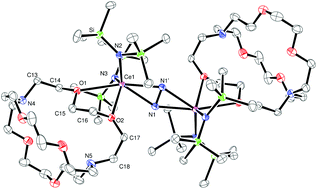Abstract
The 2.2.2-cryptand ligand (crypt) that is heavily used in reductions of rare-earth metal complexes to encapsulate alkali metals has been found to function as a bidentate ligand to rare-earth metal ions in some cases. The X-ray crystal structures of the reduced dinitrogen metal complex, [{(R2N)2Ce(crypt-κ2-O,O′)}2(μ–η2:η2-N2)] (R = SiMe3), and the ytterbium metallocene, (C5Me5)2Yb(crypt-κ2-O,O′), are presented to demonstrate this binding mode. The implications of this available binding mode in rare-earth metal cryptand chemistry are discussed.

- This article is part of the themed collection: Rare Earth Chemistry – In memory of Professor Xu Guangxian at his centenary


 Please wait while we load your content...
Please wait while we load your content...